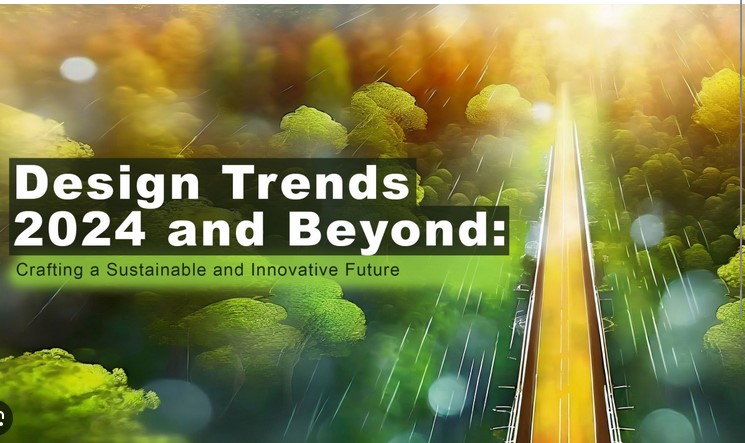Key Design Trends in 2024
As the digital and physical worlds continue to evolve, design trends in 2024 reflect a blend of innovation, functionality, and creativity. Designers across industries are embracing new technologies and rethinking aesthetics to meet the demands of a dynamic audience. The year’s trends focus on sustainability, personalization, and user-centric design, creating experiences that are both visually striking and purposeful.

1. Sustainability as a Design Priority
Sustainability remains at the forefront of design in 2024. With growing environmental concerns, brands and designers are prioritizing eco-friendly materials, processes, and designs. Sustainable design practices include the use of recycled or biodegradable materials, minimalistic packaging, and energy-efficient production techniques. This shift is evident across multiple industries, from product design to architecture, where reducing environmental impact is now a core consideration.
Consumers increasingly favor brands that show a commitment to sustainability, making it a key factor in their purchasing decisions. As a result, designers must integrate sustainability into their creative processes while maintaining aesthetic appeal and functionality.
2. Personalization in Design
Personalized design experiences continue to gain traction in 2024. As consumers expect more tailored products and services, designers are leveraging data and AI-driven technologies to create personalized experiences that resonate with individual preferences. From personalized websites and interfaces to custom product designs, personalization enhances user engagement and satisfaction.
Designers are focusing on adaptive layouts, content customization, and dynamic elements that adjust to user behaviors. This trend caters to the growing demand for experiences that feel unique, making customers feel more connected to brands and products.
3. Minimalism with a Twist
Minimalism remains a prominent trend, but in 2024, it comes with a creative twist. Designers are exploring ways to maintain simplicity while incorporating bold elements that add depth and personality. Clean lines, open spaces, and functional designs still dominate, but they are now complemented by unexpected color accents, experimental typography, and subtle textures.
This “playful minimalism” balances form and function, offering designs that are visually engaging without overwhelming the user. It reflects a desire for calm and clarity in an increasingly chaotic world, while still allowing room for creativity and expression.
4. Immersive Digital Experiences
As technologies like virtual reality (VR) and augmented reality (AR) become more accessible, immersive digital experiences are shaping the design landscape. In 2024, designers are integrating interactive and immersive elements into their projects, providing users with engaging and memorable experiences.
From AR-enhanced e-commerce platforms to VR-driven brand experiences, these technologies are changing how users interact with digital content. Designers must now consider how to create multisensory experiences that merge the digital and physical worlds, offering more than just visual appeal but also engaging sound, touch, and movement.
5. Inclusive and Accessible Design
In 2024, inclusive and accessible design continues to grow in importance. Designers are focusing on creating products and experiences that cater to a diverse range of users, including those with disabilities. Accessibility standards are now a critical component of the design process, ensuring that all users can interact with websites, apps, and products with ease.
Key elements include high contrast for readability, voice interfaces for hands-free navigation, and adaptable interfaces for users with different needs. Prioritizing inclusivity in design helps brands connect with a broader audience and reflects a commitment to social responsibility.
6. Retro Aesthetics with Modern Technology
The resurgence of retro aesthetics continues into 2024, but designers are combining vintage styles with cutting-edge technology. From the nostalgic designs of the ‘70s and ‘80s to the bold colors and patterns of the ‘90s, retro inspiration is being updated with modern design tools and interactive elements.
This fusion of old and new offers users a sense of nostalgia while still embracing contemporary functionality. Designers are using this trend to create memorable, emotionally resonant designs that capture the past while looking to the future.
7. Bold Typography Takes Center Stage
Typography plays a crucial role in design trends for 2024. Bold, oversized fonts are becoming central to design compositions, acting not only as text but as graphic elements that grab attention. Designers are experimenting with unconventional layouts, blending typography with imagery to create dynamic visuals that communicate messages clearly and powerfully.
Bold typography allows designers to convey brand identity, mood, and tone in a way that resonates with audiences instantly. This trend reflects the need for clarity and impact in an information-saturated world.
8. 3D and Motion Graphics
Three-dimensional (3D) and motion graphics continue to gain momentum in 2024. Whether for websites, advertising, or product design, 3D elements add a layer of realism and depth that captivates users. Motion graphics, in particular, provide dynamic, engaging visuals that draw attention and communicate complex ideas efficiently.
Designers are leveraging 3D tools and animation software to create visually compelling content that enhances user experiences. From subtle animations on a landing page to immersive 3D product showcases, these design elements add sophistication and interactivity to digital platforms.
9. Dark Mode Designs
Dark mode continues to be a popular design choice in 2024, with its sleek, modern aesthetic and user-friendly benefits. This mode reduces eye strain, especially in low-light environments, making it a preferred option for many users. Designers are capitalizing on this trend by creating interfaces that not only look appealing in dark mode but also offer an optimized user experience.
Incorporating dark mode into design also allows for the use of vibrant colors and highlights that stand out against dark backgrounds, creating a visually striking contrast that enhances readability and visual hierarchy.
10. Organic Shapes and Fluid Designs
Design in 2024 is moving away from rigid grids and sharp lines, favoring organic shapes and fluid designs. Inspired by nature, designers are incorporating soft curves, asymmetry, and fluid movements to create more approachable and dynamic visuals. This trend reflects a shift toward more natural, human-centered design, offering a sense of calm and comfort.
Fluid designs work well across both digital and physical mediums, allowing designers to create experiences that feel more harmonious and engaging. These shapes are often used in combination with animation and interactivity, further enhancing the user experience.



